The Rosebud Nebula is a reflection nebula located approximately 3,300 light-years away in the northern constellation Cepheus. It is also known as the Small Cluster Nebula and listed as NGC 7129 in the New General Catalogue. The nebula has an apparent magnitude of 11.5 and is 7 arcminutes across. It has a physical radius of 3 light years.
The Rosebud Nebula is associated with a young star cluster about 10 light years across, whose members illuminate the surrounding nebular material. The open star cluster contains over 130 stars with an estimated age of less than 1 million years. These young stars are responsible for producing the rosebud-shaped bubble in their parent molecular cloud. The central bubble is surrounded by a cooler molecular cloud largely invisible at infrared wavelengths.
The Rosebud Nebula was discovered by the German-born British astronomer William Herschel on October 18, 1794. It was nicknamed the Rosebud Nebula because its clouds of gas and dust form a shape reminiscent of a rosebud.
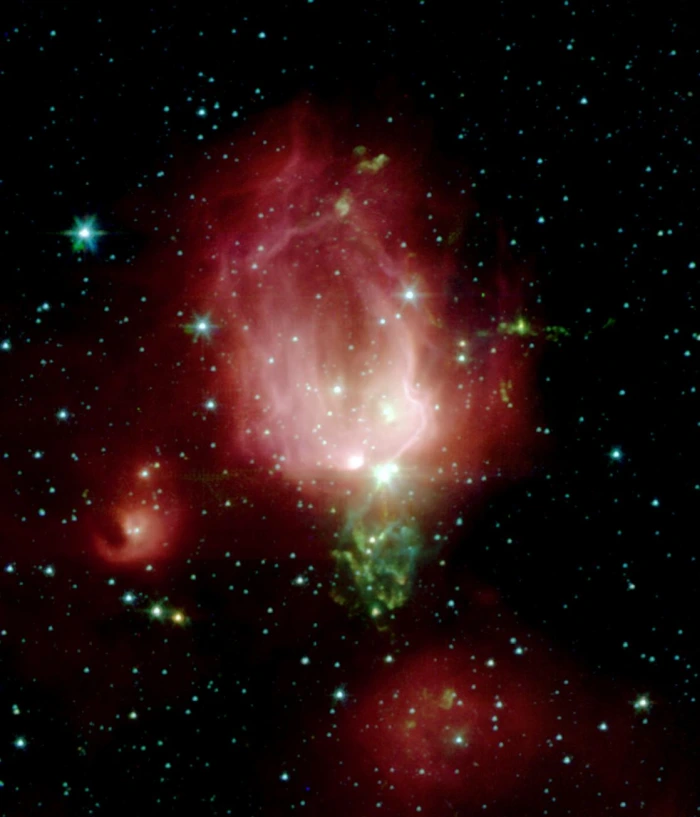
A cluster of newborn stars herald their birth in this interstellar Valentine’s Day commemorative picture obtained with NASA’s Spitzer Space Telescope. These bright young stars are found in a rosebud-shaped (and rose-colored) nebulosity known as NGC 7129. The star cluster and its associated nebula are located at a distance of 3300 light-years in the constellation Cepheus. A recent census of the cluster reveals the presence of 130 young stars. The stars formed from a massive cloud of gas and dust that contains enough raw materials to create a thousand Sun-like stars. In a process that astronomers still poorly understand, fragments of this molecular cloud became so cold and dense that they collapsed into stars. Most stars in our Milky Way galaxy are thought to form in such clusters. The Spitzer Space Telescope image was obtained with an infrared array camera that is sensitive to invisible infrared light at wavelengths that are about ten times longer than visible light. In this four-color composite, emission at 3.6 microns is depicted in blue, 4.5 microns in green, 5.8 microns in orange, and 8.0 microns in red. The image covers a region that is about one quarter the size of the full moon. Image credit: NASA/JPL-Caltech/T. Megeath (Harvard-Smithsonian CfA) (PD)
The resemblance is particularly notable in images taken by the infrared Spitzer Space Telescope in the early 2000s, in which the bluish reflection nebula appears red. Spitzer captured the rosy pink and red hues produced the glowing dust grains on the nebula’s surface. The reddish regions show the distribution of molecular material believed to contain large amounts of hydrocarbons. The Spitzer image was released for Valentine’s Day in 2004.
The dust absorbs the strong visible and ultraviolet light from the hot stars in the nebula. As the surrounding dust grains are heated by the intense light of the energetic young stars, they emit at longer infrared wavelengths.
Three stars near the nebula’s centre are sending supersonic jets into the surrounding nebula. The jets are responsible for heating molecules of carbon monoxide and producing the intricate structure that looks like the stem of the cosmic rosebud.
The Rosebud Nebula is part of a larger massive cloud of dust and gas that contains enough raw material to form at least a thousand new Sun-like stars. The radiation from the massive stars will eventually erode the massive gas cloud. As the nebula fades from view, the stars in the young cluster will slowly drift apart.
Two smaller nebulae appear near the central Rosebud. Each is home to a stellar nursery that contains only a few newly formed stars.
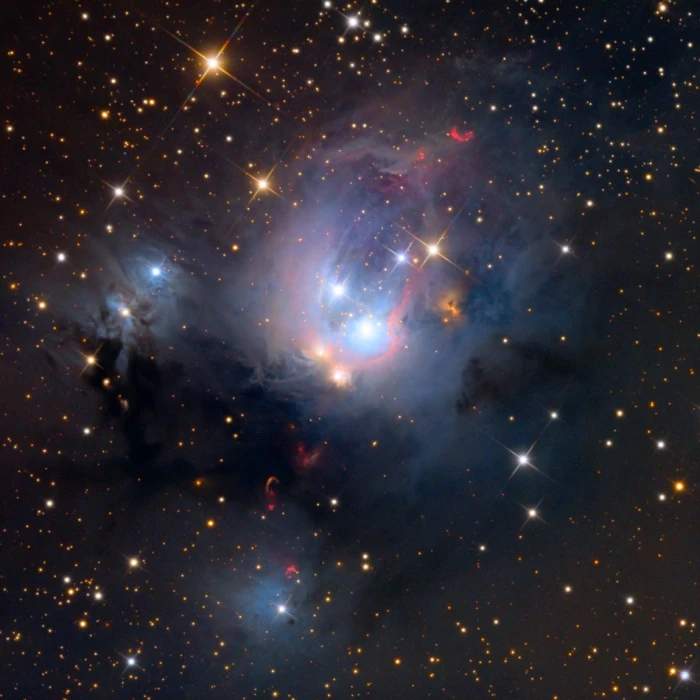
Rosebud Nebula (NGC 7129), image credit: Adam Block/Mount Lemmon SkyCenter/University of Arizona (CC BY-SA 4.0)
Location
The Rosebud Nebula lies in the far northern sky, in the constellation of Cepheus (the King). It appears within the familiar constellation figure of Cepheus, which appears as a stick house just above the brighter W pattern of Cassiopeia. Alderamin, the brightest star in Cepheus, sits at the base of the house asterism. It can be found by extending a line from Schedar through Caph, the rightmost stars of Cassiopeia’s W.
With an apparent magnitude of 11.5 and an angular size of 7 by 7 arcminutes, The Rosebud Nebula is best seen in large telescopes at high magnification.
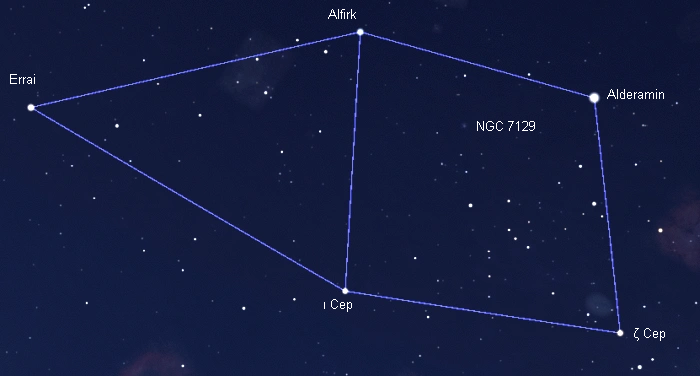
The location of the Rosebud Nebula, image: Stellarium
The nebula appears about half a degree from the open cluster NGC 7142. The star cluster shines at magnitude 9.3 from an approximate distance of 6,200 light-years. It is not physically related to the cosmic Rosebud. With an estimated age of 3 – 6 billion years, it is one of the oldest known open clusters. It can be spotted in a small telescope. The cluster is included on the Herschel 400 observing list.
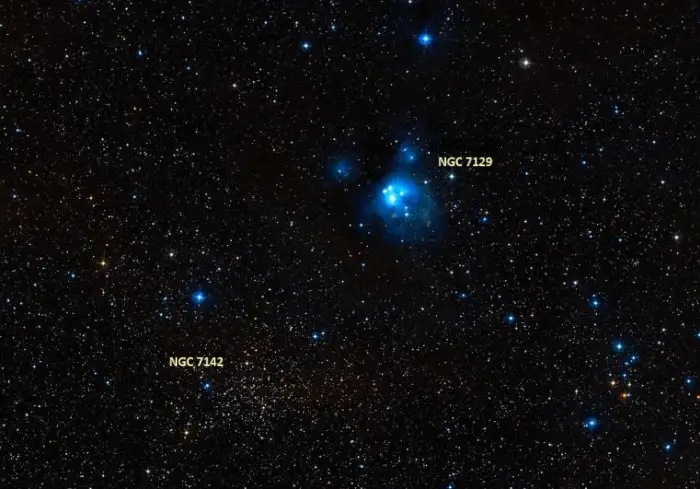
NGC 7129 and NGC 7142, image credit: ESO/Digitized Sky Survey 2 (CC BY 4.0)
At declination +66° N, the Rosebud Nebula is best seen from the northern hemisphere. It never rises above the horizon for observers north of the latitude 23-24° S and only appears very low in the sky from the southern tropical latitudes.
The best time of the year to observe the Rosebud Nebula and other deep sky objects in Cepheus is during the month of November, when the constellation is high above the horizon in the early evening. Cepheus is circumpolar in the northern hemisphere and can be seen throughout the year.
Rosebud Nebula – NGC 7129
| Constellation | Cepheus |
| Object type | Reflection nebula |
| Right ascension | 21h 42m 57.6s |
| Declination | +66° 06′ 50″ |
| Apparent magnitude | 11.5 |
| Apparent size | 7′ x 7′ |
| Distance | 3,300 light-years (1,010 parsecs) |
| Radius | 3 light years |
| Names and designations | Rosebud Nebula, Small Cluster Nebula, Cosmic Rosebud, NGC 7129, LBN 497, LBN 105.30+09.90, MWSC 3549, OCl 240, Collinder 441, Cr 441, C 2140+658 |
Images

NGC 7129 is a star-forming region that contains many interesting features. Astronomers estimate that many of the bright stars shown here are younger than 1 million years old! These “baby” stars are very energetic and emit copious amounts of radiation that break apart (photodissociate) clouds of natal gas that surrounds them. One edge of this newly formed cavity glows pink due to the excited hydrogen gas in the region. In addition, a small number of very red structures indicate regions where new stars are forming (but are not yet visible directly). These regions are often outflows of gas called Herbig Haro (HH) objects. (The crescent shaped object near the top of the nebula is HH103). Finally, energetic regions like this can often produce molecular masers. A maser (like a laser) is a coherent signal of light, generally at microwave wavelengths. In this case the molecules in this gas region are excited (vibrate) by high-energy photons and re-emit light (microwaves) to us in a preferential manner. The fascinating thing is that the molecules in question are quite important (to us): H2O (water!).This image was taken as part of Advanced Observing Program (AOP) program at Kitt Peak Visitor Center during 2014. Credit: KPNO/NOIRLab/NSF/AURA/George Seitz/Adam Block (CC BY 4.0)
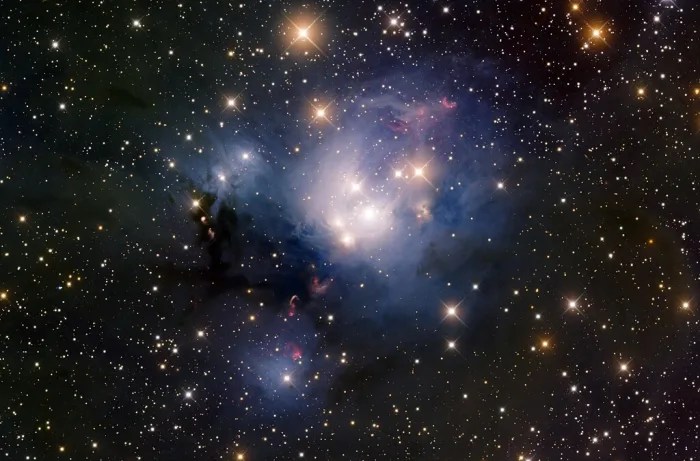
NGC 7129 is a star-forming region and reflection nebula in the constellation of Cepheus. It is about 3000 light-years away from Earth. The stars in this nebula are very young, only about a million years old. The red blobs above and below the nebula are Herbig-Haro objects, which are the result of jets of gas streaming away from young stars in the nebula. Credit: T. A. Rector/University of Alaska Anchorage, H. Schweiker/WIYN and NOIRLab/NSF/AURA (CC BY 4.0)
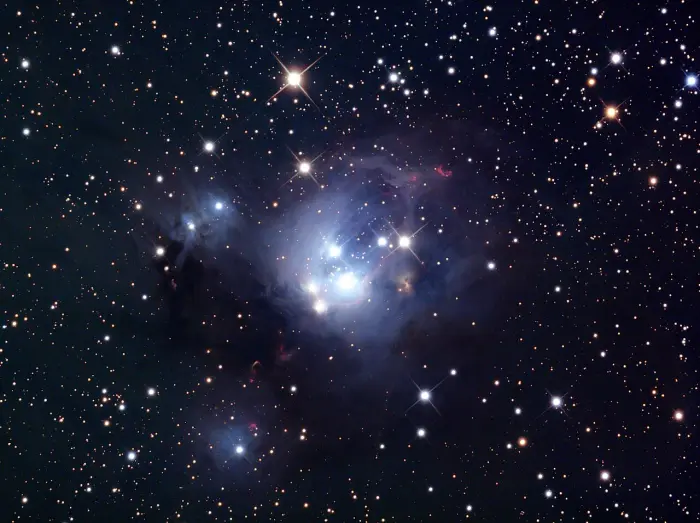
Rosebud Nebula, image credit: Wikimedia Commons/Jschulman555 (CC BY 3.0)